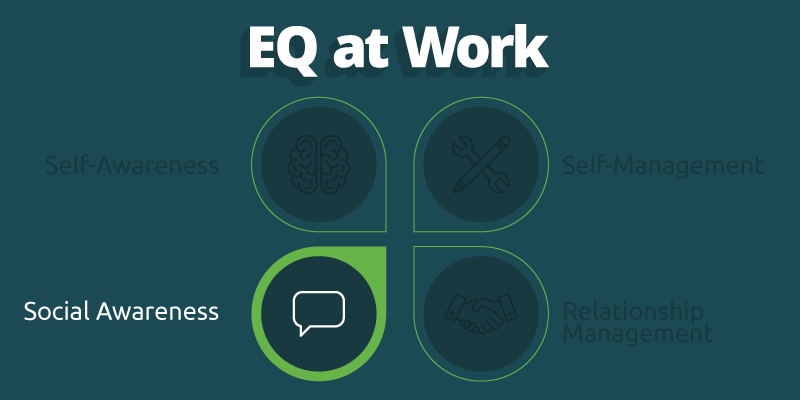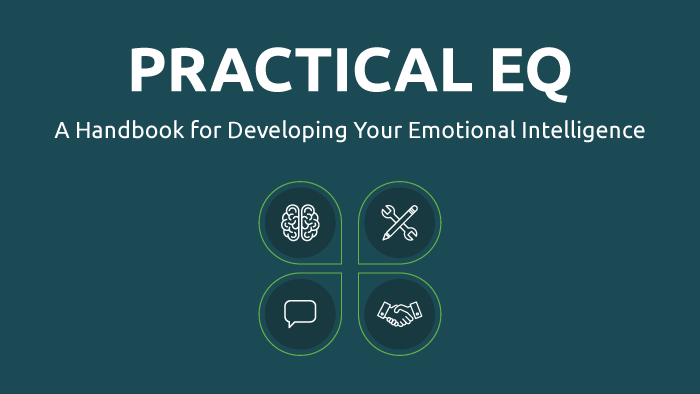This article is part three of our EQ at Work series – make sure to check out parts one and two on self-awareness and self-management, and part four on relationship management!
EQ and the Social Aspects of Work
In the previous two posts of our EQ at Work series, we talked about the first two domains of emotional intelligence (EQ), which are self-awareness and self-management, as described by author Daniel Goleman.
Many times when we’re at work, we look at how to improve relationships, teamwork, collaboration, etc. without first focusing on how we can improve our emotional skills as individuals. However, Goleman and other EQ researchers make it clear that understanding and managing the self must be a precursor to successfully understanding and managing social situations.
So, once you’ve tackled the first two domains and given your employees strategies to improve how they tune into and manage their own emotions, it’s time to look at how they can apply those skills to heighten their social awareness.
What does social awareness mean exactly? Well, social awareness is the ability to empathize and understand the viewpoints of others, even those from diverse backgrounds and cultures. This includes grasping social and ethical norms for behavior, as well as recognizing the resources and support systems within family, school, and community contexts.
Empathy is a key component of social awareness, and developing this skill can lead to a greatly improved quality of life when people learn to practice it regularly.
Empathy Is the Linchpin of Employees’ EQ
Your employees all possess a measure of empathy, some very little and some extremely high, but the majority of people will fall somewhere in the middle of this spectrum – just like with overall emotional intelligence. Empathy plays a critical role within the social awareness domain because it’s the glue that connects self-awareness to relationship management.
There have been many interesting scientific findings about empathy including in a study conducted in 2010 by Scientific American which revealed a concerning trend. Utilizing the Interpersonal Reactivity Index, one survey found that out of over 14,000 college students, nearly 75 percent rated themselves as less empathetic compared to students surveyed in 1980.
They haven’t pinpointed a reason why this particular population feels they have less empathy than 30 years ago, but an increase in social isolation is suspect, based on several studies and statistics.
Paying attention to empathetic behaviors within teams and organizations is important because lower empathy leads to less trust. When employees don’t trust their colleagues or leaders, it leads to behaviors that increase isolation and disengagement from work. A lack of trust stemming from low empathy will cause serious issues to the foundation of any organization.
The historical view of empathy in the workplace has been that it demonstrates weakness. Thankfully, this view is changing in modern workplaces. Many leaders and managers use empathy to build trust, and in so doing, increase engagement and all the business benefits that go along with it.
It’s often tempting for us to look at colleagues or employees who struggle to show empathy and think that’s a fixed part of their personality, and change is hopeless. Science shows otherwise, though, and improving empathy doesn’t require an Ebenezer Scrooge level of transformation.
Sara Konrath, whose research was described by Scientific American, says:
“The fact that empathy is declining means that there’s more fluidity to it than previously thought. It means that empathy can change. It can go up.”
Depending on the kind of training you have in place, you may or may not be familiar with how you can use online learning to improve employees’ empathy – microlearning videos are actually a very effective way to give employees greater awareness of appropriate and helpful ways to interact with others.
In our online training library, we offer a wide variety of videos on EQ topics such as developing empathy.
Ways to Improve Self and Social Awareness in the Workplace
You can be proactive in creating a more empathetic culture by helping your employees to develop their social awareness skills. In his book, The 7 Habits of Highly Effective People, Stephen Covey says the fifth habit is “Seek first to understand, then to be understood.”
Strengthening understanding of others’ emotions, motives, and desires helps your teams to be more effective, accomplishing goals that bring benefits beyond just the bottom line.
Here are a few strategies employees can use to bring their personal EQ into the social sphere:
Active Listening
Listening with the intent to gain awareness and understanding means much more than passively hearing. It means giving full attention to the person speaking, laying aside preconceived assumptions, and setting aside disruptive thoughts so the other person’s words can soak in.
“Good listeners don’t assume they know or understand a situation before hearing someone out. They listen, look for the facts of the situation, and then analyze the emotions surrounding it.”
When people consciously choose to tune in and not interrupt others with words or actions, they can significantly increase their understanding of a situation and what may be best to do or say next.
Empathetic Acknowledgement
Showing empathy does not necessarily equate to agreeing with someone’s point of view, but it does mean acknowledging their emotions and considering them when making decisions.
Empathetic acknowledgment is being sensitive to the information others share, and making sure not to invalidate their feelings by diminishing, judging, or rejecting them. When someone’s emotions are invalidated, that squashes all hope of finding understanding and building a stronger relationship.
There are lots of ways to acknowledge how someone feels without agreeing that their point of view is accurate. Here are a few examples:
- “I haven’t had that experience myself, but I can imagine how difficult it is.”
- “I hear your concern and appreciate that you care.”
- “I can understand why that is upsetting for you.”
Asking Guiding Questions
The best way to strengthen social awareness is by asking questions to better understand people and situations. This is how healthy discourse plays out and difficult conversations lead to helpful solutions.
Questions lead to awareness, which leads to understanding, which leads to finding solutions and building relationships.
Here are some basic guiding questions that can be useful in emotional conversations:
- “Do you think that’s really what’s upsetting you, or could it be something else?”
- “Could this stem from a miscommunication or an assumption?”
- “What do you think would be the best next step?”
Improving social awareness takes time, but when your employees are committed to better understanding others and their environment, you’ll see plenty of positive impacts to your culture.
To help your employees develop EQ, check out our free handbook with simple practices and reflection questions:
Read part one: EQ at Work: Developing Employees’ Self-Awareness
Read part two: EQ at Work: Self-Management Skills for Your Employees
Read part four: EQ at Work: Relationship Management Fundamentals

